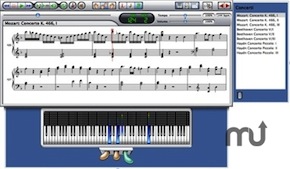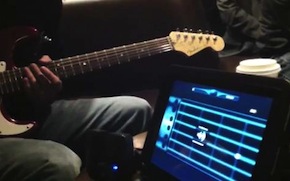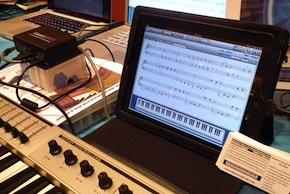
The average teenager in the 1980s donned a mullet and played the air guitar while jumping on his parents’ couch. In the ’90s, teens grew into grunge couture, dyed hair, and holey jeans but still settled for rockin’ out in the mosh pit. By the 2000s, video games like Guitar Hero and Rock Band had arrived, bringing the music closer. Now, with a phone or other smart device in the hand of almost every other adolescent, amateur rock-a-holics as well as aspiring pianists can learn to play the guitar or the piano for the price of a mobile app.
Two applications, Home Concert Xtreme by Zenph Sound Innovations, and Rock Prodigy, recently made waves at the S.F. Music Tech Summit on the music education and technology front. They raise the questions: Is this style of learning the wave of the future? And, how did these apps get here?
Featured Video
“I personally went to school for jazz, classical guitar, [and] was a touring musician for a while and I noticed my wife playing and having a great time with Guitar Hero and Rock Band. It was the easiest thing. [I thought], Oh my gosh. It should be a real instrument and she should be playing real music on a real instrument,” said Harold Lee, cofounder of Rock Prodigy. “At that time, Tyson [Butler] and I were at UCLA Anderson [School of Management] getting our MBAs, and we pitched it as a project for an entrepreneurship course and it was well-received. So, literally since early 2008, we’ve been working on making a business out of this concept, and we finally were able to get the technology put together.”
“What our app does is let you hear what you’re supposed to sound like. It lets you see what to do.” – Harold Lee, cofounder of Rock Prodigy
By far, one of the biggest complaints about Guitar Hero, Rock Band, and previous music apps, regardless of the platform, is that they have nothing to do with playing a real instrument — since they don’t show the correct fingering, lack the correct amount of strings, and “don’t even teach you anything about the chords.” Until now, almost every app or video game lacked either the music theory or the physical instrument to aid in the music-making process. But Rock Prodigy’s creators believe they have the perfect blend of education, technology, and fun that will make music more accessible to as many people as possible.
Quick Gratification

“Our company is fundamentally a music education company and, with our background and our training in music education, one thing that we noticed as a problem with music education is that it’s not often that it’s immediately gratifying or fun,” said Lee. “What our app does is let you hear what you’re supposed to sound like. It lets you see what to do, precisely synchronized to what you’re hearing, which are the best tracking and performance cues. Then super, super-importantly, you get the real-time feedback in the polyphonic music detection.”
After downloading the app onto an iPad or iPhone, you plug a guitar into the computer or the phone, using the appropriate adapter, and begin to learn the correct fingering, chord names, and technique of how to play a selected song. Still, apps are no substitute for music lessons. They merely aid in the learning process and give hope to those unable to afford private lessons.
“There are lots of apps out there that are nothing more than toys,” remarked George Litterst, chief creative officer and chief technology officer of Zenph Sound Innovations. “At the same time, there are apps out there that invite active and meaningful engagement in the music-making process. And if anything, what these — at least the good ones — do is to encourage more music-makers. I would qualify it and say some are just tools. Some are toys and some are very helpful tools. So, one does have to be discriminating.”
With the massive growth of social media and its ever-increasing effect on everyday life, greater numbers of people are content creators.
Home Concert Xtreme (HCX) was made specifically with music students and teachers in mind. It works with MIDI tracks (computer-created realizations of music), which are found in many music education books, and it displays the notation of a song, by part and by track.
“It works interactively with MIDI files and any MIDI keyboard that can be plugged into the iPad,” said Litterst. “These MIDI files work in a plug-and-play fashion with our app. So what happens is, with our app, you open up the MIDI file of the piece that you want to learn and there are many tracks in that piece. We display, by default, the piano tracks — left-hand and right-hand keyboard parts — and the notation on the screen.”
HCX, which won the 2010 Frances Clark Award for Keyboard Pedagogy and is emblematic of what’s going on with music education. Litterst, who also teaches piano, doesn’t see an end to mobile devices assisting, but not replacing, music education.
“What I think that we’re seeing is that, as computers or computing devices become more portable, such as with tablets, and as the software becomes more intelligent, such as being able to react to the player, we’re going to be seeing more and more of these kinds of innovations,” he said. “There’s no doubt about that.”
My Generation
But what does it all mean? Is this just another new fad, or will apps actually become a part of the music-making process? One answer is the closing gap that’s evident between artist and audience.
“Since we are a young company,” said Rock Prodigy’s Lee, “we’ve only been in the, more or less, public [eye] this short period of time. But the guiding principle, some core values are: One, [we’ve] gotta be artist-friendly because it’s all about the people who make the music. They should love working with us, and so far we’ve had — I like to think — a great relationship with who we’ve been working with. Two, we want to make this available to as many people as possible because we’re all about whatever is going to make more musicians by learning music. So, yes, we want the consumer to be closer to the artist and we’re just going to stay out of the way. We’re going to make them love the artist even more by saying, ‘Oh my gosh. I’m playing it now, and this is more ingenious than I ever imagined!’”
With the massive growth of social media and its ever-increasing effect on everyday life, greater numbers of people are content creators. “Back then,” digital rights management was an up-in-the-air, unfamiliar topic. Now, social media participants are taking personal responsibility by becoming part of the music-making process in their thirst for interactivity. These days, the audience can easily become the artist. And with Rock Prodigy and Home Concert Xtreme, that dream is one step closer.
“In the artist community, we are very much focused on the artist and their fans and the experience. And so we think that this is just an entirely new way for fans to appreciate music like never before,” said Rock Prodigy’s cofounder and CFO, Tyson Butler. “Our point of view is that there’s no better way to appreciate music, their favorite artist, than to actually learn to play their music. And we think that sort of helps enhance that relationship between the artist and their fans. It’s an entirely new way to engage with each other.”
Such innovations could also mean the growth of distance learning. Sound Innovations, in particular, hopes to use software, such as Internet City, to make music education a possibility for more people.
“There’s definitely a trend in music education toward distance learning, and our company, Sound Innovations, is actually a leader in that area,” said Litterst. “[Internet City] is capable of connecting two MIDI instruments together over the Internet. When you are giving a lesson to a student and you play, you’re playing your instrument and your student’s instrument, and vice versa. Then you add intelligent music-graphic display on the screen, and you can see what the teacher or the student is doing and show notes on the staff and analyze them and do all sorts of things. You are using the distance [and] time and place between people — and, again, you’re providing more access to lessons and education. And I think that’s going to become increasingly popular.”
Let It Rock
Rock Prodigy made a splash at the SF Music Tech Summit just last month, where SFCV got to see attendees interact with the app. (Audio recordings available here.) But how does it do with real students? And does it have any drawbacks?
“It’s better suited for an electric instrument, [say] for an electric guitar, because it has a built-in microphone, than for an acoustic guitar,” said Johnny Lukashevich, a professor at the Rock Academy of Chicago. “But the tracking — in other words, how accurate it is — seems to work a little better with an electric guitar. That’s been not necessarily a huge problem, but it is something I’ve noticed.”
All of Lukashevich’s students — introductory, intermediate, and advanced — really like the app, though he notes that it works best with his intermediate students. Yet there’s no getting around a live lesson or the fact that there are still costs associated with new technology, such as purchasing an iPad or an iPhone.
“I would like to see the cost come way down on music technology, because it seems to me now you have to be of a certain income level to afford proper technology,” said Lukashevich. “Like all technology, eventually the price will drop and we’ll see a little more access without such a high price tag. That’s what I hope will happen, anyway.”
If the goal is music for all, the industry still has a long way to go. The artist–audience and student–teacher connections are a start.
“We just want to be the vehicle to enable that connection, that interaction,” said Lee. “And our [app] will do it in a totally unique way. That’s the vision for Rock Prodigy.”

